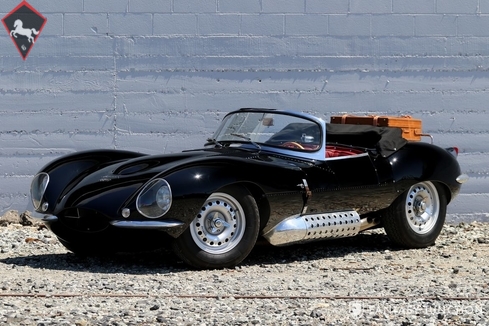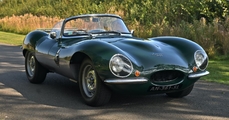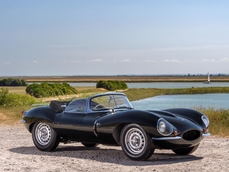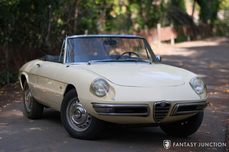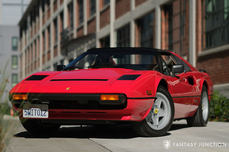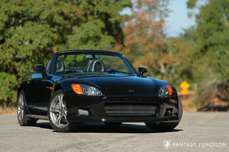Jaguar XKSS 4.2 Litre DOHC Inline 6-Cylinder 1957
Allgemeine Beschreibung :
1957 Jaguar XKSS Recreation by Lynx
s/n 1E30084
Black with Red Leather Interior
Among the most beautiful automobiles ever conceived and crafted, the Jaguar XKSS is today regarded as one of the most desirable sportscars of the modern era. First constructed in 1957, the Jaguar factory converted twenty-five remaining racing D-Types (then under construction) into road-going configuration. This fortuitous conversion, a requirement to compete in the North American SCCA racing series, proved to be a delight for motoring enthusiasts all over the world. By adding a full-width glass windscreen, bumpers, passenger door, and a host of other detailed finishing elements, these twenty-five cars would serve as ambassadors to Jaguar’s largest and growing export market – North America. Sadly, a devastating fire at the factory destroyed the XKSS production line, tragically eviscerating nine of these exceptional factory cars. Only sixteen of the original cars survived. Over the years, particularly as values for the remaining sixteen cars have escalated into the millions, much lore has transpired regarding the nine vanquished cars, adding further to the mystique of these beautiful Jaguars. Most recently, Jaguar Cars has announced they will build the phantom nine XKSS cars as a “continuation” XKSS series, faithfully based on the original specifications in tribute to those lost in the fire. Even though these cars are still under construction, all of the nine cars have already sold for well over a million dollars each.
In 1968 a group of intrepid Sussex based motorsports enthusiasts established Lynx Engineering to tune and repair specialized British race cars. By 1972 the team cultivated the notion that legendary British sports cars could be fitting subjects for revival and began building accurate recreations of the Jaguar D-Type, C-Type, E-Type Lightweight, and the iconic XKSS. With many of the craftsmen from the original period still alive and eager to apply their artistry to such projects, Lynx was able to employ methods and construction techniques identical to the original designs, with results that accurately mirrored the original examples. Artisans worked to not only achieve the beauty and excellence in the recreations, but also worked concurrently on restoration projects, applying accuracy and technical facility to each of their Lynx offerings. The results of these combined talents have yielded remarkable cars that truly honor these legends in both beauty and performance.
This particular XKSS Recreation by Lynx was specifically constructed in 2016 and completed in 2017 on special order for the North American Lynx Representative, the first and only owner of this stunning alloy-bodied hand crafted sportscar. Recorded as the thirteenth of sixteen constructed to date, the handmade aluminum tub was fabricated to exacting standards and dimensions. Construction included a new handmade monocoque tail section and bonnet in 16 swg aluminum as well as a left-hand drive monocoque with an extended footwell and re-positioned seat back panels to allow for additional legroom. A new uprated front chassis frame was constructed using Reynolds tubing and original specification XKSS hood, bumpers, and luggage rack were installed. The windscreen frame was formed using 16 swg aluminum per the original XKSS with an original specification windscreen specially molded using laminated safety glass from Lynx tooling.
The handmade construction of this Lynx XKSS was combined with the majority of components from 1964 Jaguar XKE #30084, purchased by the owner for use in fabrication. Both a build plate and corresponding body number plate are present and riveted to the appropriate sections of the car. Utilizing several major components from the donor XKE (used as well for the registration and title on the car), the twin cam 4.2 liter Jaguar engine was comprehensively refurbished including the head which was aluminum gas flowed and blue printed with enlarged ports, and fitted with a specialized Lynx Weber gas flowed intake manifold and triple Weber 45DCOE carburetors. Internally, the engine was rebuilt with Lynx competition steel rods, a lightened and balanced forged crankshaft, and Lynx semi-competition camshafts. The exhaust manifolds were specially constructed for LHD as was the hand built stainless steel exhaust system. A high efficiency aluminum radiator, low profile cooling fan, and Lynx D-Type aluminum header tank were installed to meet the cooling needs. A Getrag 5-speed gear box was installed featuring a 9.5” clutch and lightened flywheel. Utilizing the front and rear suspension from the XKE, Lynx upgrades to dampers, bushings, and improved adjustable torsion bars were just a few of the many suspension improvements to enhance handling and durability. A competition modified and rebuilt Salisbury power-lock differential was installed with rear axle ratio 3.07:1.
Among the many additional features included during the build, exceptional care was given to the safety and security of the brakes, fuel system, and electrical components. All brake lines were constructed with Kunifer tubing and braided Aeroquip flexible lines using multi-pot Lynx front calipers and XJS solid disc brakes. A 30-gallon aluminum fuel tank was installed with an electronic Hyco fuel pump and braided fuel lines. Electronic ignition and a high capacity competition alternator and a lightweight starter were also installed. Original specification 16” x 6” alloy Dunlop wheels with pegdrive hubs and chrome plated knockoffs were shod with Vredestein Sprint Classic radial tires. The interior was finished with a satin black dashboard and McQueen cubby box, seatbelts, McQueen specification XKSS seat cushions, and a specially built original specification D-Type quick release steering wheel. Other notable items include removable side curtains, a hidden electrical cut-off switch, Lynx dry sump lookalike system, a Sonnenland top, Lynx carburetor trumpets, polished aluminum bumpers, Monza fuel cap, rear light plinths, Halogen H4 headlamps, and headlamp cover trim.
During the year-long fabrication from 2016-2017, the owner was fortunate to be able to document the construction featuring hundreds of detailed photographs showing multiple components being assembled and prepared for installation. These photos not only document the fastidious Lynx workmanship and attention to detail, they visually catalog multiple aspects of the complex build and precise specifications. After the car was completed and delivered to the current owner, he showed the car in several events frequently taking home awards of distinction including 1st place at the 2017 Jaguar Clubs of North America Championship SE Regional Concours and 1st place at the 2017 Jaguar Clubs of North America “International Jaguar Festival”.
Exemplary in every aspect, this Lynx XKSS is stunningly finished with smooth and glossy black Glasurit paint beautifully applied to the hand formed alloy body panels. The exquisite form and superb craftsmanship are all the more impressive when seen in gorgeous black reflections. The fit and finish of all surfaces and openings is composed to exacting standards. Virtually all bright work and polished accessories are lovingly presented, accenting against the fluid black surfaces of the sensuous fender lines. The pouncing stance is perfectly composed resting eagerly on the alloy D-Type Dunlop wheels and correctly specified Vredestain tires. The look and feel of the powerful stainless side exhaust against the curvaceous body creates a brilliant juxtaposition of power and grace. Wonderful period correct details include leather bonnet latches, lever arm locks, hood script lettering, Monza fuel filler, and aircraft inspired riveted body panels. Even the hand-crafted custom luggage case is constructed with vintage charm and elegance.
The interior is handsomely tailored with attention to detail consistent with the original XKSS, but allowing for safety and ease of use under modern road conditions. Here again, the use of aircraft construction methods in the raw aluminum monocoque are revealed throughout the riveted floor and welded lap fold construction of the interior. The red leather seats are formed to allow for slightly more driver and passenger space, working well with the larger dimension foot box area and slightly reduced diameter of the wood and aluminum steering wheel. Black dial Smith instruments are accurately arrayed with the controls, switches, and key features easily at hand. Additional handsome polished aluminum and plated touches appear throughout the interior including on the switchgear, hand brake and various trim throughout the aviation-inspired cockpit. Accessing the rear spare tire compartment, the hand formed tailgate drops open revealing a matching spare wheel captured by a proper leather strap, fixed into position beneath the accessory rack. Virtually every aspect of the construction is honest, authentic, and reflective of the original intent and design Jaguar envisioned for these rare road cars.
Under the hood resides a gloriously finished 4.2 Liter Jaguar E-Type engine, enhanced by a polished twin cam head and triple Weber carburetors featuring a specially constructed Lynx polished intake manifold, Weber carburetors, and polished trumpets. The engine compartment is fitted with a polished aluminum water tank, handsomely blued stainless-steel exhaust tubes, handmade riveted bulkhead construction, and other delightful mechanical details, completing the look of this very capable and stunningly equipped XKSS. The underside of the car also features correctly finished components, superlative construction, mechanical integrity, and minimal evidence of use since construction was completed only two years ago.
With the twist of the key and a press on the starter button, the mighty twin-cam ignites to life and slowly settles into a smooth but deeply engaging idle, hinting at the race-inspired origins of these iconic Jaguars. Driving position is well laid out and surprisingly spacious owing to the additional occupant space designed into construction for this specific car. And while a bit of learning is required settling into driving position, once nestled inside, you instantly become unified with the car. Operating temperatures come up quickly, all instruments indicate properly, and, with a blip of the throttle you are quickly on the road. Shifting is easy through the 5-speed synchromesh transmission with power coming on progressively, yet still offering sharp bursts of acceleration when commanded with authority, due in part to the semi-competition cams and triple Webers. Cornering is wonderful either at highway speeds or while escaping to lush mountain roads where the independent suspension and fantastic brakes can truly show their capability. Overall the ride engineering and composure are impressive and engaging, especially when considering the era of conception. Included with the car are several documents supporting the build and components, a copy of the original title for the XKE donor car, and reference photos of the factory construction.
This phenomenal XKSS is ready to deliver undeniable pride of ownership and superlative driving enjoyment at a fraction of the cost of the original. Wonderfully constructed by a cadre of world renown fabricators to exacting standards. This beautifully prepared Lynx XKSS honors the lineage of these multi-million dollar cars not only for their profound beauty and success on legendary racetracks, but for the stunning and innovative engineering that continues to inspire enthusiasts all over the world.
https://fantasyjunction.com/inventory/1957-jaguar-xkss-recreation-by-lynx/overview
1957 Jaguar XKSS 4.2 Litre DOHC Inline 6-Cylinder is listed verkauft on ClassicDigest in Emeryville by Fantasy Junction for Preis nicht verfügbar.
Fakten der Auto
Karosserietyp : Auto Marke : Jaguar Modell : XKSS Ausführung : 4.2 Litre DOHC Inline 6-Cylinder Hubraum : 4.2 Modelljahr : 1957 Lage : Emeryville Fahrzeug Anmeldung : Normal
Verkauft
Angaben Zum Verkäufer
Verkauft
People who viewed this Jaguar XKSS also viewed similar Jaguar listed at ClassicDigest
Other cars listed for sale by this dealer
über Jaguar
Ah, die Geschichte von Jaguar, von seinen Anfängen als SS Cars Ltd. bis hin zum Höhepunkt mit dem D-Typ und der Straßenversion des ikonischen E-Typs. An dieser Erzählung haftet etwas zutiefst Britisches, und ich werde sie erzählen, wie es ein britischer Journalist tun würde.Die Anfänge:
Unsere Reise in die Welt von Jaguar beginnt in den 1930er Jahren, als ein Unternehmen namens SS Cars Ltd. auftauchte. Trotz des unglücklichen Zufalls ihrer Initialen, die mit den aufkommenden politischen Spannungen in Europa zusammenfielen, begannen sie, stilvolle und leistungsorientierte Autos herzustellen. Der SS 100, der 1936 eingeführt wurde, war ein Symbol für Eleganz und Geschwindigkeit und legte den Grundstein für das, was Jaguar werden sollte.
Die Geburt von Jaguar:
Als der Schatten des Zweiten Weltkriegs näher rückte, entschied sich SS Cars Ltd. klugerweise, sich von den SS-Initialen zu distanzieren. So wurden sie 1945 offiziell zu Jaguar Cars Ltd., ein Name, der bald für britischen Luxus und Leistung stehen würde.
Die XK-Serie:
Die Nachkriegszeit von Jaguar brachte uns den XK 120, eine wahre Sensation im Jahr 1948. Mit seinem schlanken Design und einem leistungsstarken 3,4-Liter-Sechszylindermotor wurde er zum schnellsten Serienauto der Welt. Der XK 120 war die Blaupause für das, was kommen würde - Jaguars, die Stil mit Geschwindigkeit auf einzigartig britische Weise verbanden.
Die Dominanz des D-Typs:
Dann kam der D-Typ, eine wahre Rennlegende. 1954 eingeführt, gewann er in den 1950er Jahren dreimal Le Mans und zeigte die technische Kompetenz von Jaguar. Mit seiner innovativen Monocoque-Konstruktion und der ikonischen Finne hinten war der D-Typ der Höhepunkt von Jaguars Motorsporterfolgen.
Das Auftauchen des E-Typs:
Aber der wahre Wendepunkt kam 1961 mit der Einführung des E-Typs, oft von Enzo Ferrari als "das schönste Auto, das je gebaut wurde" bezeichnet. Seine lange Motorhaube, die geschwungene Karosserie und ein 3,8-Liter-Motor, der atemberaubende Leistung lieferte, machten ihn sofort zu einem Klassiker. Der E-Typ war nicht nur ein Auto; er war ein Kunstwerk auf Rädern und konnte auf der Straße 150 Meilen pro Stunde erreichen.
Straßen- und Rennsporterfolge:
Die Schönheit des E-Typs wurde durch seine Leistung auf der Rennstrecke unterstrichen. Die leichten E-Typen waren bei verschiedenen Rennveranstaltungen besonders erfolgreich und festigten den Ruf von Jaguar als eine Kraft, mit der man im Motorsport rechnen musste.
Das Zeitalter der Raffinesse:
Je tiefer wir in die Geschichte von Jaguar eintauchen, desto mehr erkennen wir, dass die 1950er und 1960er Jahre ein Zeitalter der Raffinesse und Expansion waren. Neben dem großartigen D-Typ und dem ikonischen Aufstieg des E-Typs führte Jaguar Modelle ein, die seinen Ruf für Luxus und Leistung weiter festigten.
Der MK2:
Ende der 1950er Jahre stellte Jaguar den MK2 vor, eine Sportlimousine, die Eleganz mit Leistung vereinte. Diese elegante viertürige Limousine war sowohl bei Bankräubern als auch bei der Polizei aufgrund ihrer außergewöhnlichen Geschwindigkeit und Handhabung beliebt. Der MK2 war ein Symbol für Jaguars Fähigkeit, Raffinesse mit Leistung zu verbinden und hatte auch eine erfolgreiche Rennkarriere.
Der XJ6:
Springen wir ins Jahr 1968, als Jaguar ein Auto auf den Markt brachte, das Jahrzehnte lang Luxuslimousinen definieren würde - den XJ6. Es war ein Meisterwerk der Ingenieurkunst und des Designs, mit einem sanften Reihensechszylindermotor, unabhängiger Hinterachse und einem geräumigen, wunderschön ausgestatteten Innenraum. Der XJ6 war ein Symbol britischer Eleganz und bot eine so sanfte Fahrt, dass es schien, als würde er förmlich über die Straße gleiten. Er wurde zum Flaggschiffmodell für Jaguar und setzte den Maßstab für Luxuslimousinen und zeigte ein Maß an Raffinesse, das die Konkurrenz staunen ließ.
Die Verschmelzung von Klassik und Moderne:
Während der MK2 und der XJ6 die Evolution der Limousinen von Jaguar repräsentierten, bewahrten sie das Engagement der Marke für Leistung und Luxus. Diese Autos gehörten nicht nur auf die Rennstrecke; sie fühlten sich genauso wohl auf den Prachtstraßen wie auf einer entspannten Fahrt durch die englische Landschaft.
Die Herausforderungen des Wandels:
Dennoch sah sich Jaguar mit dem Eintritt der 1970er Jahre, wie viele britische Automobilhersteller, finanziellen Herausforderungen und Veränderungen in der Eigentümerschaft gegenüber. Die Ära von British Leyland brachte sowohl Chancen als auch Schwierigkeiten mit sich, während die Marke durch verschiedene Fusionen und Übergänge navigierte.
Das Erbe des MK2 und des XJ6, zusammen mit dem D-Typ und dem E-Typ, definiert Jaguar weiterhin als einen Hersteller, der zeitlose Eleganz mit einer Leistungsstärke vereint. Diese klassischen Modelle, ob sie über kurvige Straßen gefahren oder als Sammlerschätze geparkt werden, dienen als Zeugnis für die anhaltende Präsenz von Jaguar in der Welt der automobilen Exzellenz.
Die Jaguar-Geschichte, von ihren Anfängen als SS Cars Ltd. bis zur Schaffung von Automobilikonen wie dem E-Typ, dem MK2 und dem XJ6, ist eine Reise, die das Wesen des britischen Automobilbaus widerspiegelt - eine Mischung aus Luxus, Leistung und Stil, die nach wie vor Enthusiasten und Kenner gleichermaßen fasziniert.
